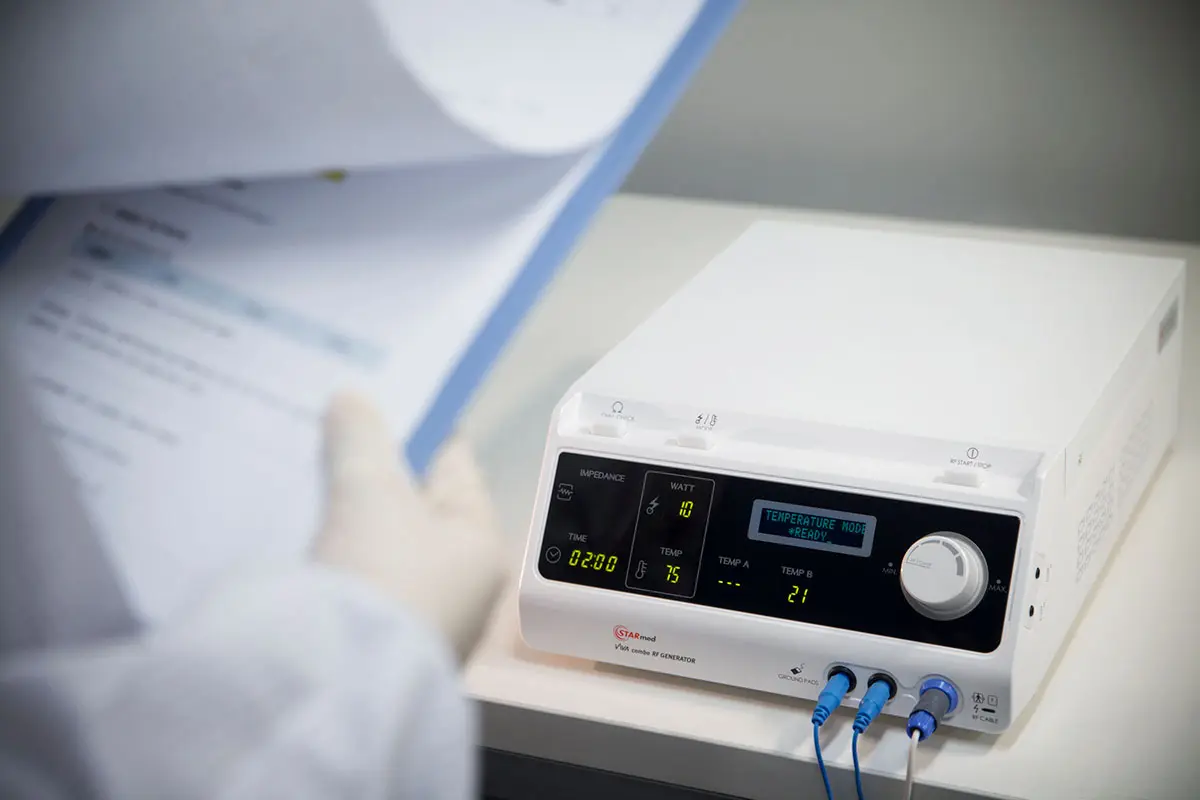TL;DR: Radiofrequency ablation (RFA) and thyroid artery embolization (TAE) are minimally invasive alternatives to surgery for shrinking benign thyroid nodules. This blog compares both methods, helping clinicians evaluate which approach fits their patients’ needs based on mechanism, effectiveness, recovery, and risk.
- RFA uses heat to directly destroy nodule tissue.
- TAE blocks blood supply to induce nodule shrinkage.
- RFA is ideal for single nodules; TAE is better for large or multinodular goiters.
- Both are outpatient procedures with fast recovery.
- RFA typically offers 70–80% reduction at 1 year.
- Both treatments preserve thyroid function and avoid surgical risks.
The treatment for thyroid nodules has evolved beyond traditional surgery. Several minimally invasive alternatives, such as embolization and ablation, have emerged in recent years. Both options are proving to be safe and effective treatment modalities for many patients.
Both ablation and embolization aim to shrink or eliminate benign nodules. Clinicians choose these modalities to help patients avoid scarring, long recovery times, and the need for lifelong medications.
Embolization and ablation both differ in approach, ideal use cases, and outcomes. In this blog, we will break down what each procedure entails. We will compare their key differences for the benefit of clinicians considering adopting these therapies.
Continue reading to find the ideal treatment modality for your practice and patient population.
Radiofrequency Ablation for Thyroid Nodules (Thyroid Nodule Ablation)
Radiofrequency ablation (RFA) of thyroid nodules is a thermal ablation technique. Under ultrasound guidance, an electrode needle is inserted into the thyroid nodule. The electrode delivers high-frequency electrical current that generates heat to destroy the nodule tissue.
The ablated cells then undergo coagulative necrosis and are gradually resorbed by the body over time. This causes the nodule to shrink. RFA precisely targets the nodule and spares healthy thyroid tissue, helping preserve overall gland function.
Thyroid Embolization Procedure (Thyroid Artery Embolization)
Thyroid artery embolization (TAE) is a newer, vascular approach to treating thyroid enlargement. During thyroid embolization procedures, an interventional radiologist inserts a catheter via a small puncture in the groin or arm. They then navigate into the arteries supplying the thyroid gland. Tiny particles are then injected to block the blood flow to the targeted tissue.
By cutting off the blood supply, the overgrown thyroid tissue becomes ischemic. This leads to the death of the nodule. At that time, the tissue will be reabsorbed, shrinking the thyroid mass.
Ablation vs Embolization: Key Differences and How to Choose
Both RFA and TAE represent important advances in nonsurgical thyroid nodule treatment. However, the two procedures are not interchangeable.
Below is a breakdown of embolization vs ablation for thyroid nodules.
Mechanism of Action
Thyroid ablation (RFA) uses thermal energy delivered via a needle to destroy thyroid nodule cells directly. In contrast, thyroid embolization (TAE) uses particles to choke off blood flow to thyroid tissue. That process causes the cells to die from lack of circulation.
In both cases, the result is an inactive, shrunken nodule or gland after the body resorbs the treated tissue.
Best Candidates
RFA is ideal for a single benign thyroid nodule or a few nodules that are causing symptoms or hyperthyroidism. It targets a specific nodule with pinpoint accuracy.
Embolization is better suited for larger or multinodular goiters. For example, a patient with numerous nodules or a very large, diffuse goiter may benefit more from TAE.
Essentially, RFA is focal, while TAE can treat a broader region of thyroid tissue at once.

Procedure Setting
RFA is typically performed in an office setting with local anesthesia. During RFA, the patient is awake and experiences minimal discomfort.
TAE requires an angiography suite, typically in a hospital or outpatient surgical center. An interventional radiologist must be present during TAE. Patients are usually mildly sedated during the procedure.
Both RFA and TAE are outpatient procedures with no overnight hospital stay needed.
Recovery and Side Effects
Recovery times are short for both embolization and ablation.
RFA tends to have virtually no downtime. Patients often resume normal activity within hours. In contrast, TAE patients might experience a day or two of neck soreness. Some also experience a low fever due to post-embolization inflammation.
Neither procedure leaves a visible scar.
RFA may cause a temporary voice change or minor bruising in a few cases. TAE can cause a transient inflammatory response. Serious complications are uncommon for both procedures.
Efficacy in Shrinking Nodules
Both methods effectively shrink targeted tissue. However, the typical use cases of each treatment modality differ.
On average, clinicians performing RFA can expect to see roughly a 50 to 75% nodule volume reduction at 6 months. They have observed a 70 to 80% reduction at 1 year post-RFA. Ongoing data suggests that volume reduction is durable and often continues to improve over time.
TAE can debulk very large goiters by 50–80% or more, which is useful in cases that would otherwise need extensive surgery.
Occasionally, clinicians consider a combined approach to treatment. For example, they might perform an embolization first to shrink a massive goiter. Then, they may perform RFA on any remaining nodular tissue.
Risks
Both RFA and TAE help patients avoid the risks of surgery. For example, neither TAE nor RFA cause general anesthesia complications, infection, or permanent hypothyroidism.
RFA’s risk profile is very low, with minor complications in only ~2 to 4% of patients. There is virtually no risk of life-threatening events.
TAE’s risks demand special caution to prevent non-target embolization, however. There is a small risk of embolic material affecting other organs if it refluxes. Thus, experience, quality training, and proper technique are critical.
Overall, both procedures have far fewer complications than surgery. They also both preserve the thyroid gland, which has the potential to improve a patient’s quality of life.
Explore Thyroid RFA with STARmed America
As the demand for non-surgical thyroid care grows, now is the time to consider adopting radiofrequency ablation. Discover how STARmed’s precision RFA tools support safe, effective thyroid nodule reduction.





